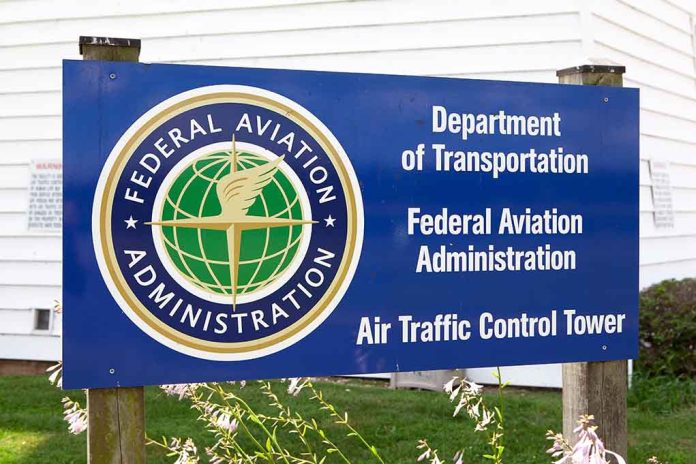
Newark Liberty International Airport operated with just three air traffic controllers instead of the required 14, causing flight delays of up to seven hours and raising serious concerns about America’s air travel infrastructure.
Key Takeaways
- Newark Liberty International Airport faced a critical shortage with only three radar controllers on duty instead of the required 14, causing severe flight delays.
- Transportation Secretary Sean Duffy announced plans to reduce flights at Newark and described the national air traffic control system as “antiquated,” with plans for a complete overhaul.
- The airport has experienced three recent communications blackouts, affecting the control tower’s ability to track or communicate with planes.
- Secretary Duffy has proposed raising the mandatory retirement age for air traffic controllers from 56 to 61 to address a nationwide shortage of approximately 3,000 controllers.
- Officials emphasize that flight reductions are being implemented for safety reasons, not to inconvenience travelers.
Severe Controller Shortage Creates Dangerous Situation
The Federal Aviation Administration confirmed that Newark Liberty International Airport operated with as few as three radar controllers during shifts, far below the staffing levels needed to efficiently manage one of the nation’s busiest airspaces. This critical shortage resulted in flight delays stretching up to seven hours as the remaining controllers struggled to maintain operations. The staffing crisis comes amid a series of telecommunication failures that have further complicated the airport’s operational challenges, raising concerns about the broader state of America’s air traffic control system.
FAA spokesperson Rick Breitenfeldt acknowledged the situation, stating, “at least three controllers were scheduled for each hour” and insisting that, “We plan for staffing with traffic management initiatives to ensure safety is never compromised.” The agency implemented traffic management initiatives to maintain safety standards, but the severe understaffing reflects a growing national crisis in air traffic control personnel. Neither the FAA nor the air traffic controllers union have responded to inquiries about their staffing level agreements.
NYT: Newark Airport had 3 controllers on duty when the goal Is 14 https://t.co/kB1PWRZ0NS
— Geoff Bennett (@GeoffRBennett) May 13, 2025
Multiple System Failures Compound Staffing Issues
Newark’s challenges extend beyond staffing shortages. The airport has experienced three communications blackouts recently, severely impacting the control tower’s ability to track and communicate with aircraft. These technical failures have prompted some controllers to take stress-related leave, further exacerbating the staffing crisis. The problems are linked to outdated copper wiring at the Philadelphia Terminal Radar Approach Control (TRACON) facility, which took over Newark’s approach control responsibilities after operations were transferred from Long Island last summer.
The Philadelphia facility currently operates with 22 fully certified controllers, five supervisors, and 21 controllers in training. While a recent software update prevented a complete outage during the latest telecommunications issue, the repeated failures highlight the fragility of the current system. Secretary Duffy criticized the previous administration for mishandling the transfer of air traffic control responsibilities from Long Island to Philadelphia, adding to the operational challenges.
National Crisis Demands Immediate Solutions
The situation at Newark reflects a nationwide shortage of approximately 3,000 air traffic controllers. Secretary Duffy has proposed raising the mandatory retirement age for controllers from 56 to 61 as one measure to address the staffing crisis. Additionally, he announced plans to reduce flights at Newark, particularly during peak international arrival times, for several weeks to ensure safety while the staffing and technical issues are addressed. The FAA is also working on an extensive plan to modernize the national air traffic control system.
John Hansman, an aviation expert from MIT, indicated that while controller shortages typically result in traffic slowdowns rather than direct safety threats, the ongoing issues have caused significant anxiety among travelers. Similar disruptions have occurred at other major airports, including Atlanta’s Hartsfield-Jackson. Despite the inconvenience to passengers, Newark’s mayor supported the flight restrictions, emphasizing that safety must take precedence over convenience as officials work to address both immediate staffing needs and the underlying structural problems in America’s air traffic control system.
Sources:
As few as 3 radar controllers monitored Newark’s airspace Monday night, FAA says
As few as 3 radar controllers monitored Newark’s airspace Monday night, FAA says
Newark airport had three air traffic controllers on duty instead of 14







